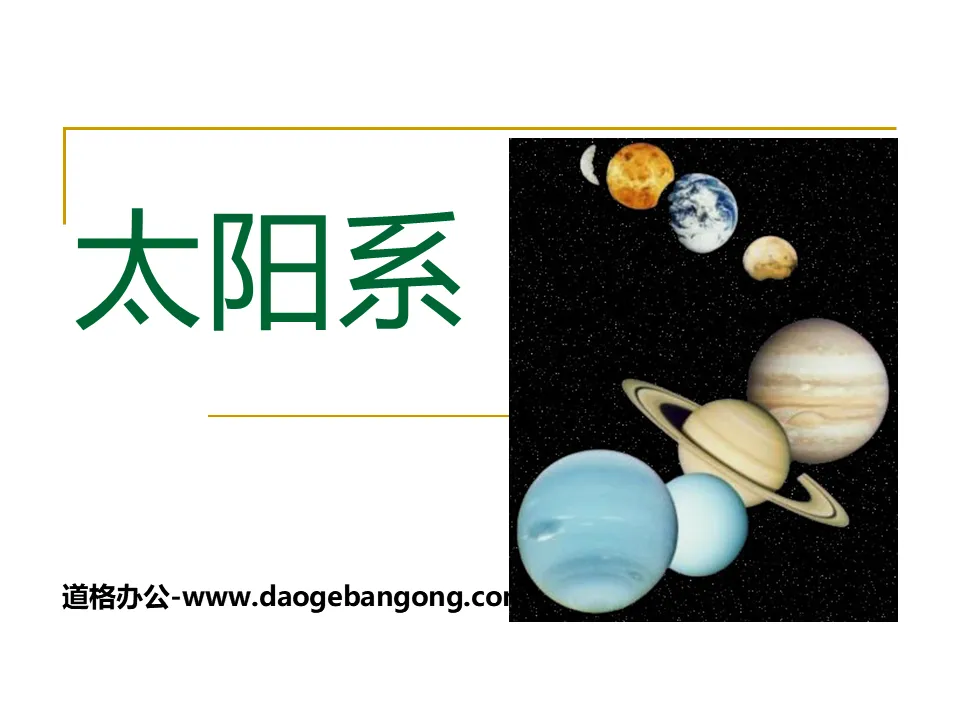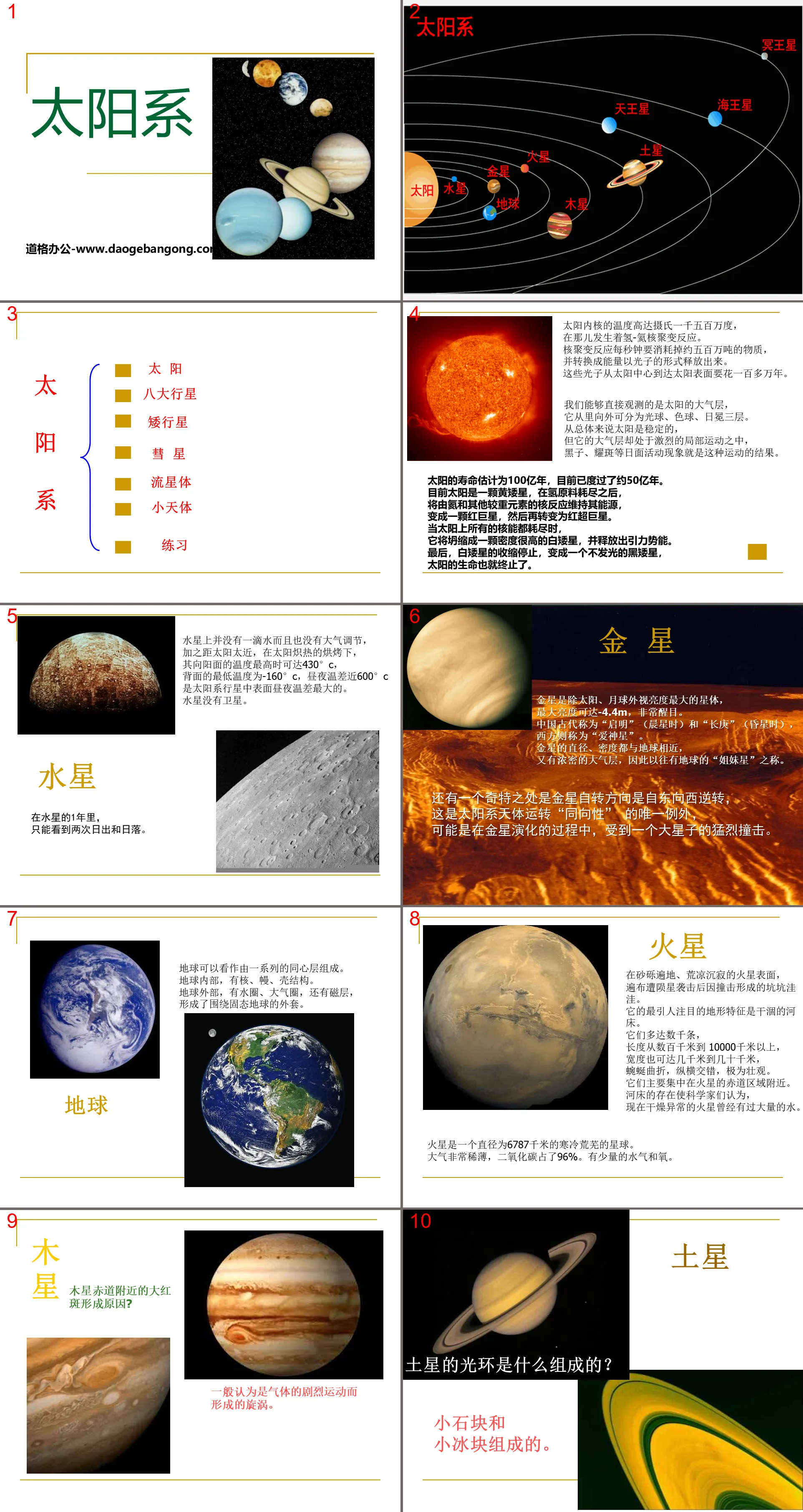Fifth Grade Science Volume 1, Textbook Edition
Science Edition for Sixth Grade Science Volume 2
Third Grade Science Volume 2, Textbook Edition
Science Edition for Sixth Grade Science Volume 1
Third Grade Science Volume 1, Textbook Edition
Fourth Grade Science Volume 2, Textbook Edition
Fourth Grade Science Volume 1, Textbook Edition
Qingdao Edition Fourth Grade Science Volume 2
Hunan Education Edition Fourth Grade Science Volume 1
E-education edition fifth grade science volume 2
E-education edition fifth grade science volume 1
Qingdao Edition Fifth Grade Science Volume 2
Fifth Grade Science Volume 2, Textbook Edition
Zhejiang Education Edition Seventh Grade Science Volume 2
Fourth-grade science volume 2 of the E-education edition
Hunan Education Edition Fifth Grade Science Volume 2

| Category | Format | Size |
|---|---|---|
| E-education edition sixth grade science volume 2 | pptx | 6 MB |
Description
"Solar System" PPT courseware 4
The temperature in the core of the sun is as high as 15 million degrees Celsius, where the hydrogen-helium nuclear fusion reaction occurs.
The nuclear fusion reaction consumes about five million tons of material every second and converts it into energy and releases it in the form of photons.
It takes more than a million years for these photons to travel from the center of the sun to the surface.
What we can directly observe is the sun's atmosphere, which can be divided into three layers: photosphere, chromosphere, and corona from the inside to the outside.
Generally speaking, the sun is stable, but its atmosphere is in intense local motion. Solar surface activity phenomena such as sunspots and flares are the result of this motion.
The sun's lifespan is estimated to be 10 billion years, and it has currently spent about 5 billion years.
The sun is currently a yellow dwarf star. After the hydrogen material is exhausted, its energy will be maintained by the nuclear reaction of helium and other heavier elements, becoming a red giant, and then transforming into a red supergiant.
When all of the sun's nuclear energy is used up, it will collapse into a dense white dwarf star and release gravitational potential energy.
Finally, the contraction of the white dwarf stops and it becomes a black dwarf that does not emit light, and the life of the sun ends.
Mercury
In Mercury's year, you can only see two sunrises and sunsets.
There is not a drop of water on Mercury and there is no atmospheric regulation. In addition, it is too close to the sun. Under the blazing heat of the sun, the temperature on its sunny side can reach up to 430°C, and the lowest temperature on the back side is -160°C, day and night. The temperature difference of nearly 600°C is the largest between day and night on the surface of any planet in the solar system.
Mercury has no moons.
Venus
Venus is the brightest star outside the sun and the moon. The maximum brightness can reach -4.4m, which is very eye-catching.
In ancient China, it was called "Qiming" (morning star time) and "Changgeng" (evening star time), and in the West it was called "Eros".
Venus's diameter and density are similar to those of the Earth, and it has a dense atmosphere. Therefore, it used to be called the Earth's "sister star."
Another peculiarity is that the rotation direction of Venus is reversed from east to west. This is the only exception to the "isotropic" rotation of celestial bodies in the solar system. It may be that during the evolution of Venus, it was violently impacted by a large planetesimal.
The most famous comet: Halley's comet
What is the orbital period of Halley's Comet?
76 years
The last time it appeared was in 1986, when will it next appear on earth?
2062
A child saw Halley's Comet when he was 10 years old. How old was he when he saw it for the second time?
Meteoroids are small solid objects in the solar system
Meteors: When meteoroids approach the Earth's orbit, some are captured by the Earth's gravitational field. When they rush into the Earth's atmosphere, they burn with friction, producing a flash of light called a "meteor."
Meteoroids that have not burned up and fall to the earth's surface are called meteorites.
1. What are the two largest planets in the solar system? What are their greatest features?
The names of the two largest planets are: Jupiter and Saturn
They have common characteristics: a solid core and an atmosphere several kilometers thick, large size, many satellites, and a halo.
2. What is the brightest planet in the solar system?
Venus
3. Which planet in the solar system has the most satellites?
Jupiter
4. The asteroid belt is located between which two planets?
Mars and Jupiter
5. Briefly describe whether the nine planets have atmospheres and their characteristics.
Keywords: Solar system teaching courseware, E-education edition sixth grade science PPT courseware download for the second volume, sixth grade science slide courseware download, solar system PPT courseware download, .PPT format;
For more information about the "Solar System" PPT courseware, please click the Solar System ppt tag.
"Solar System" universe PPT teaching courseware:
"Solar System" Universe PPT teaching courseware Part One: Review of the previous section 1. When do solar and lunar eclipses generally occur in the lunar calendar? What moon phase? 2. What are the types of solar and lunar eclipses? 3. Try to explain the reasons for the solar eclipse in your own words. 4...
"Solar System" universe PPT download:
"Solar System" Universe PPT download Part 1: Introduction of new lessons In addition to the earth and the moon, what other celestial bodies do we know that are moving around the sun? What are the characteristics of these celestial bodies? How are they arranged? ... ... ... Solar system PPT, second...
"Solar System" Universe PPT:
"Solar System" Universe PPT Part 1 content: Understand that the solar system is centered on the sun, including the eight major planets that revolve around it (including satellites that revolve around the planets), dwarf planets, and small celestial bodies (including asteroids, meteors, comets, etc.) The system is called...
File Info
Update Time: 2024-09-08
This template belongs to science courseware E-education edition sixth grade science volume 2 industry PPT template
"Solar System" PPT courseware 4 Simple campus recruitment activity planning plan summary enterprise and institution recruitment publicity lecture PPT template is a general PPT template for business post competition provided by the manuscript PPT, simple campus recruitment activity planning plan summary enterprise and institution recruitment promotion Lecture PPT template, you can edit and modify the text and pictures in the source file by downloading the source file. If you want more exquisite business PPT templates, you can come to grid resource. Doug resource PPT, massive PPT template slide material download, we only make high-quality PPT templates!
Tips: If you open the template and feel that it is not suitable for all your needs, you can search for related content "Solar System" PPT courseware 4 is enough.
How to use the Windows system template
Directly decompress the file and use it with office or wps
How to use the Mac system template
Directly decompress the file and use it Office or wps can be used
Related reading
For more detailed PPT-related tutorials and font tutorials, you can view: Click to see
How to create a high-quality technological sense PPT? 4 ways to share the bottom of the box
Notice
Do not download in WeChat, Zhihu, QQ, built-in browsers, please use mobile browsers to download! If you are a mobile phone user, please download it on your computer!
1. The manuscript PPT is only for study and reference, please delete it 24 hours after downloading.
2. If the resource involves your legitimate rights and interests, delete it immediately.
3. Contact information: service@daogebangong.com
"Solar System" PPT courseware 4, due to usage restrictions, it is only for personal study and reference use. For commercial use, please go to the relevant official website for authorization.
(Personal non-commercial use refers to the use of this font to complete the display of personal works, including but not limited to the design of personal papers, resumes, etc.)
Preview










